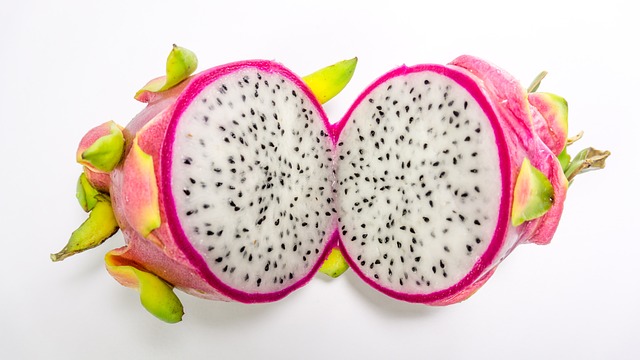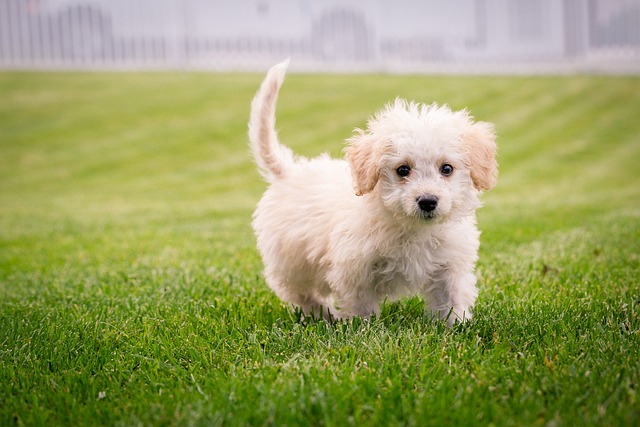
Dragon fruit, known for its vibrant pink skin and refreshing crunch, is not just a tasty delight for humans but also a potential treat for our furry friends. When considering incorporating new foods into your dog’s diet, it’s essential to understand the implications for their health and well-being. This article delves into the question of “can dogs eat dragon fruit?” and looks at the nutritional benefits, potential risks, and guidelines for safe consumption.
Table of Contents
Is Dragon Fruit Good For Dogs?
Dragon fruit can be a safe treat for dogs when given in moderation. Always be sure to check with a veterinarian before offering your pup new foods, like dragon fruit. Unlike some fruits that dogs can eat, such as honeydew, dragon fruit can be higher in natural sugar, and so moderation is key. Thus, while this can be a nutritious snack for them, there are still some potential risks and considerations:
- Allergic Reactions: As with any new food, there’s a possibility of an allergic reaction. It’s best to introduce dragon fruit slowly and monitor your dog for any adverse reactions.
- Portion Control: Overeating dragon fruit can lead to digestive issues such as diarrhea because of its high fiber content, or lead to weight gain. It’s important to feed dragon fruit in moderation as part of a balanced diet.
- Pesticide Exposure: Choose organic dragon fruit when possible and always thoroughly wash the fruit to reduce the risk of pesticide exposure.
How much Dragon Fruit Can Dogs Eat?
When introducing dragon fruit to your dog’s diet, it’s essential to consider their size and weight to determine the appropriate serving size. Below is a general guideline on how much dragon fruit dogs can likely consume, but always consult with a veterinarian first:
- Extra Small (<10 lbs): Start with a small piece, about less than 1 teaspoon, to gauge their reaction.
- Small (10-25 lbs): A piece equivalent to about 1 teaspoon is a safe starting point.
- Medium (25-60 lbs): Begin with about 2 teaspoons of dragon fruit.
- Large (60-100 lbs): Large dogs can start with 3 teaspoons of dragon fruit.
- Giant (100+ lbs): Giant breeds can have up to about 1 tablespoon of dragon fruit as a starting portion.
Remember, these amounts are guidelines and should be adjusted based on your dog’s individual health, dietary needs, and how they respond to dragon fruit and its taste. Always introduce new foods gradually and monitor your pet for any signs of a negative reaction and be sure to consult with a veterinarian first for personalized advice first.
Nutritional Benefits of Dragon Fruit
Dragon fruit, also known as pitaya, is a low-calorie fruit that’s full of nutrients like vitamins, minerals, and dietary fiber. Other health benefits of dragon fruit include:
- Digestive Health: The fiber content in dragon fruit can help with digestion and possibly prevent constipation in dogs, helping out your dog’s digestive tract.
- Immune System Support: Dragon fruit contains vitamin C, calcium, and phosphorus, which can contribute to a dog’s overall health. Other antioxidants, like flavonoids, phenolic acid, and betacyanin, can help combat free radicals.
- Skin and Coat Health: The omega-3 and omega-6 fatty acids can contribute to a shiny and healthy coat.

How to Feed Dragon Fruit to Dogs
- Start Small: Begin with a small piece of dragon fruit to see how your dog reacts, too much dragon fruit can cause stomach upset in dogs.
- Remove the Skin: The skin of the dragon fruit is not easily digestible and should be removed before feeding it to your dog.
- Serving Size: Chop the dragon fruit into small, manageable pieces for your dog to reduce the risk of choking.
- Serve Fresh: Fresh, raw dragon fruit is the best option for dogs. Avoid processed dragon fruit products that may contain added sugars or preservatives.
Allergies
While dragon fruit is generally considered safe for dogs, as with any food, there’s a possibility that some dogs might have an allergic reaction to it.
Possible signs of an allergic reaction to dragon fruit in dogs could include:
- Skin Irritations: Symptoms like itchiness, redness, rashes, or hives on the skin could occur. The dog might excessively scratch or bite at the skin.
- Gastrointestinal Issues: Symptoms might include vomiting or diarrhea after consuming dragon fruit, or general abdominal discomfort.
- Ear Infections: In some cases, food allergies can lead to recurrent ear infections.
- Respiratory Symptoms: Although less common, some allergic reactions can lead to respiratory issues such as sneezing, coughing, or difficulty breathing. This is more often seen in the case of a severe allergic reaction.
- Swelling: Swelling around the face, lips, eyelids, or ears can also be a sign of an allergic reaction. This requires immediate veterinary attention.
It’s important to introduce dragon fruit, or any new food, into your dog’s diet gradually and in small amounts to monitor for adverse reactions. If you suspect your dog is having an allergic reaction to dragon fruit, it’s best to discontinue feeding it and consult with a veterinarian for advice and proper management.
Dragon fruit can be a healthy and exotic treat for dogs when introduced properly and consumed in moderation. Its nutritional benefits can make it a welcome addition to your dog’s diet. However, it’s crucial to monitor your dog for any signs of allergies or digestive upset and to consult with a veterinarian if you have any concerns about introducing new foods to your pet’s diet. As with any treat, dragon fruit should be given as part of a balanced diet and not replace a complete and balanced dog food.
FAQ
Can Dogs Eat Dragon Fruit Skin?
Many wonder: can dogs eat dragon fruit skin? Generally, it is not recommended because the skin of the dragon fruit can be tough and hard for dogs to digest. It is recommended that you peel or otherwise remove the skin of the dragon fruit before feeding it to your dog as it could possibly cause digestive upset or pose a choking hazard.
Can Dogs Eat Dragon Fruit Seeds?
The black seeds of dragon fruit are very small and rather inextricable from the white flesh, so they are okay for your dog to eat. However, too many might be an issue and difficult for your dog to handle so be sure to monitor their intake and watch for signs of adverse reactions.
Can Dogs Eat Dragon Fruit Juice?
Avoid giving your dog fruit juices that have been processed and often have high sugar content which could lead to obesity. It’s best to stick with fresh dragon fruit without any additives to ensure their safety and health. Before giving dogs dragon fruit, always consult with a vet to make sure it is safe for your specific pup.
Recipes
Dragon fruit can be a refreshing and healthy treat for dogs when prepared simply and without any added sugars or complex ingredients that could upset their stomach. Here are a few simple dragon fruit recipes you can try for your furry friend:
Fresh Dragon Fruit Cubes
Ingredients:
- Ripe dragon fruit (peeled).
Instructions:
- Cut the dragon fruit in half and scoop out the flesh.
- Dice the flesh into small, bite-sized cubes appropriate for your dog’s size.
- Serve a few cubes as a treat, or add them to your dog’s meal for a fruity surprise.
Dragon Fruit Frozen Treats
Ingredients:
- Ripe dragon fruit (peeled).
- Water.
Instructions:
- Puree the dragon fruit flesh in a blender. For added hydration, you can mix in a little water.
- Pour the puree into an ice cube tray or silicone mold.
- Freeze until solid, then pop out a cube as a cool treat on a hot day.
Dragon Fruit Smoothie
Ingredients:
- Ripe dragon fruit (peeled)
- A banana (optional)
- A splash of water
Instructions:
- Blend the flesh of the fruit with a small slice of banana for added sweetness and creaminess. Add a little water to achieve the desired consistency.
- Serve a small amount of the smoothie in your dog’s bowl or freeze it in ice cube trays for a frozen treat.
When preparing these treats, always consider your dog’s size and dietary needs. Treats should only make up a small portion of your dog’s diet and not replace their regular, balanced meals. If your dog has never had dragon fruit or any of the other ingredients before, start with a tiny amount to ensure they don’t have an adverse reaction and consult with a vet before serving.


